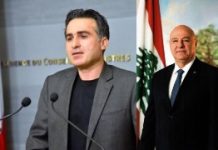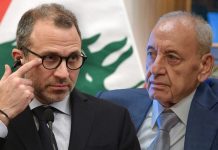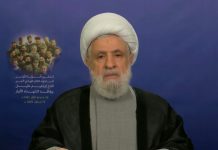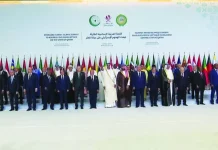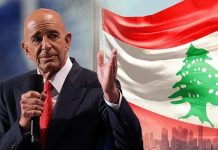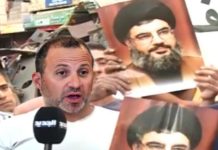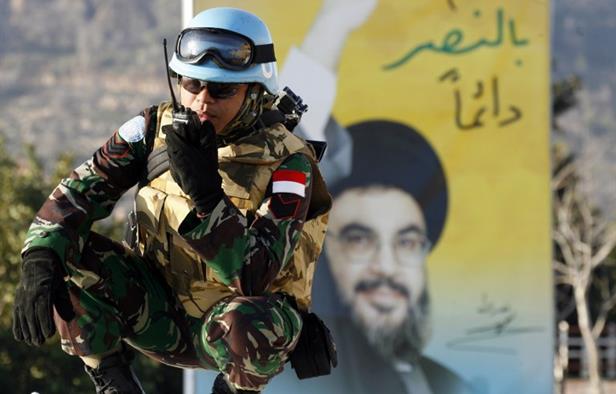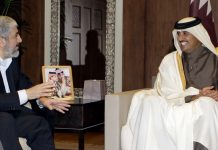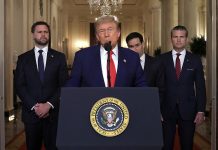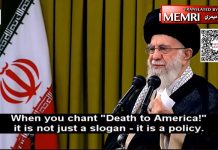Ten reasons Hezbollah should be worried
Nicholas Saidel/Now Lebanon/Published: 27/01/2015
Why Hezbollah, Iran, the Assad regime and their supporters should be concerned about the future of the Party of God
The future of Hezbollah seems bright from afar. The party has grown numerically and expanded geographically; has drastically improved its missile, rocket and drone arsenal; and has become a battle-hardened fighting force from its experience in the ongoing war in Syria. Looking back to victories such as in Qusayr and Yabroud, Hezbollah has shown much capability in defending the Assad regime. Some would even argue that were it not for Hezbollah, the government in Syria would have fallen long ago. Now advising and training Shiite militias in Iraq, as well as paramilitary forces in Syria — with the help of the Iranian Revolutionary Guards Corps (IRGC) — Hezbollah has augmented its military reach into Mesopotamia and the broader Middle East, to countries including Yemen and Bahrain. The scope of this Lebanese-based Shiite militia is truly global; its operatives are deployed in places as far away as Southeast Asia and South America, for money laundering, drug and weapons trafficking, and to potentially launch attacks on Western, Israeli and Jewish targets. While Hezbollah is part of the Lebanese government, it is nonetheless able to operate with virtual impunity inside Lebanon’s borders.
Notwithstanding the above, below are 10 reasons why Hezbollah, Iran, the Assad regime and supporters of this “Resistance Axis” should be concerned about the future of the Hezbollah:
First, Hezbollah’s image is tarnishing. There was one embarrassing resignation in late 2014, which has put the party in a negative spotlight at a very critical time. Also, leaks to the media indicate that members of Hezbollah will soon be summoned before the Special Tribunal for Lebanon (STL), a body formed pursuant to the UNSC resolution to investigate the death of former Lebanese Prime Minister Rafik Hariri. If Hezbollah is implicated, which wouldn’t surprise many, this will be just one more piece of evidence proving to the Lebanese that Hezbollah acts not for Lebanon, but for itself and its Iranian patrons. Whereas once Hezbollah was seen as the “Resistance,” the defender of Lebanon’s border with Israel and the champion of Palestinian rights, its Iranian-guided role in Syria has created a domestic marketing problem for Hezbollah, one that is developing traction in academic, editorial and political circles and that could have deleterious consequences for the party down the line.
Second, Hezbollah fighters are being killed at an unsustainable pace. Approximately 1,000 Hezbollah fighters have been killed in action in Syria, some of whom were senior Hezbollah commanders. These severe losses, given that there are around 5,000 Hezbollah fighters in Syria, means that approximately one in five are being killed. This slow bleed, now playing out in cities such as Aleppo where Hezbollah is facing an emboldened Jabhat al-Nusra, cannot be maintained. To make matters worse, recent reports indicate that the Islamic State (ISIS) is gaining ground in Syria notwithstanding coalition airstrikes. Also, the Iraqi Shiite militias that were acting as a support force for Hezbollah are returning to Iraq to fend off the onslaught of ISIS there, leaving Hezbollah with fewer troops as it coordinates efforts with an increasingly incompetent and defection-prone Syrian Army as its local sponsor. Iran has had to deploy its own troops to make up for this loss in manpower, an unambiguous sign that Hezbollah is feeling the effects of its costly adventurism into the Syrian theater.
Third, Hezbollah has confirmed infiltration by its arch enemy intelligence service, Israel’s Mossad. In light of the Mossad penetration deep into the ranks of Hezbollah, the party will now have to divert more resources to counterintelligence moving forward, which will be difficult as the availability of skilled manpower dwindles.
Fourth: a combination of oil and governance issues. The 50% drop in oil prices since last June has forced Hezbollah to implement salary cuts and otherwise tighten its belt in spending, which will only add incentive to those within Hezbollah who are already pilfering from Hezbollah’s Iranian largesse. Hezbollah’s inability to root out corruption partially stems from the fact that it is relying more and more on new, un-vetted and sometimes very young recruits, whose ideology (or lack thereof) may not be necessarily aligned with the party. These are ordinary Lebanese citizens, Syrian refugees, or Palestinian refugees usually affiliated with the Popular Front for the Liberation of Palestine (PFLP), some of whom aren’t Shiite, who for protection for themselves and their families or out of financial necessity have joined Hezbollah’s ranks but have not gone through the necessary institutional controls that weed out individuals who may have a more sordid agenda. Hezbollah’s rapid expansion since the Syrian uprising, which was not coupled with any correlated changes in governance structure or policy, has arguably exacerbated its previous vulnerability to corruption and scandals.
Fifth: sanctions and a Syrian political solution that does not include Bashar al-Assad. The Western-imposed sanctions on Russia and Iran could potentially weaken both countries’ leverage against the West in terms of removing Assad from power. So far, the West hasn’t applied the requisite pressure to take advantage of its heightened leverage, but it may do so in the future — especially considering the more muscular foreign policy envisioned by the new Republican-majority US Senate. If a more hawkish candidate than President Barack Obama is elected president in America in 2016, there could very well be American boots on the ground in Syria operating not only to degrade and destroy the likes of the Nusra Front and ISIS, but also to assist the Free Syrian Army (FSA) in defeating the Assad regime. If Assad were removed from power, it could affect Hezbollah’s relationship with Syria and the party’s access to vital Syrian supply routes. Relevantly, prominent opposition groups like the Syrian National Council have gone on record stating that a post-Assad Syria would cut ties with the Iranian Axis and thus Hezbollah. In a recent interview with Al-Mayadeen, even Hezbollah Secretary General Hassan Nasrallah massaged his previously unambiguous language regarding Assad’s permanence as the president of Syria, stating: “Even if the political solution means that Assad should go after the end of his term, this should be in coordination with him.”
Sixth, Hezbollah is now forced to deal with rival Shiite political organizations, religious and secular thought leaders back home in Lebanon who are undermining the party’s authority. This is a somewhat new phenomenon, and while Hezbollah is still the party with the guns, this movement could grow to become a mitigating force to Hezbollah’s influence within Lebanon. While Hezbollah has successfully dealt with (read: coopted) its historical rival, the Amal Movement, it is now facing empowered groups such as the Lebanese Option Party, and religious leaders such as Ali al-Amine and the late Hani Fahs — whose visions for Lebanon’s future do not align with Hezbollah’s Iranian-focused agenda. This is in addition to the myriad Lebanese intellectuals and journalists, e.g. Hanin Ghaddar, who have courageously spoken out against Hezbollah in recent times.
Seventh, the Lebanese Armed Forces (LAF), once thought of as a somewhat ineffective force in comparison to Hezbollah and one that still has a complicated relationship with non-Shiite populations in Lebanon (read: mistrust) and with Hezbollah, has recently proven itself to be the more competent domestic policing and law enforcement entity when fighting against the same terrorist and guerrilla warfare tactics that Hezbollah perfected against the IDF. The LAF’s victory in securing Tripoli, capturing Sunni jihadist cells in Saida and the recapture of Arsal are evidence of its mounting ability to fight terrorism. Just recently, the LAF thwarted what would have been a series of suicide attacks, making three arrests and dismantling a bomb-laden car on the outskirts of Arsal. Also, the LAF has proven itself to be highly resilient to defections, notwithstanding the fact that approximately half of its forces are Sunni, illustrating the public’s rising trust in the LAF as a state institution. On the flip side, Hezbollah has demonstrated in Syria an inability to develop efficient counter-insurgency strategies, such as fighting from fixed positions, holding territory, and detecting IEDS and ambushes before they occur. For its part, the LAF has had ample external support. The US, France, Saudi Arabia, and Great Britain have committed themselves to funding and equipping the LAF with arms, vehicles (both land and air) and tower structures that give it the qualitative edge it needs to combat the likes of ISIS and Nusra.
Eighth, Hezbollah’s deterrence against Israel is arguably deteriorating. Israel has been hitting weapons convoys and caches in Syria and, at least in one instance in early 2014, inside Lebanon, destined for Hezbollah, in part, to maintain air supremacy and to ensure Hezbollah will not possess any “game changing” armaments in any future war with the Jewish state. Israel wisely hits Hezbollah in Syria for the most part to lessen Hezbollah’s potential justifications for a military response since it is a Lebanese organization operating without formal authority on foreign (i.e. Syrian) soil. The most recent Israeli air assault played out in Quneitra, Syria, along Israel’s northern border on 18 January 2015. Significantly, the strike came well after the latest Mossad agent was arrested — possibly this was in part an Israeli message to Nasrallah that Israel’s spy network against Hezbollah is vaster than previously known. The Apache helicopter attack on a Hezbollah convoy killed six Hezbollah members as well as six Iranian soldiers. The casualties included senior Hezbollah commanders from the elite Raduan Force and one Iranian general. Hezbollah will most likely respond by resorting to the very pedestrian tactic that is becoming the norm; planting IEDs near Israeli patrols in the Shebaa Farms/Mount Dov region along the Israeli border — hardly a proportionate response.
It seems as though Hezbollah — possibly on orders from Iran in light of the delicate nuclear negotiations or because of Hezbollah’s fear of a full-scale war with Israel while embroiled in a seemingly endless conflict in Syria — is not currently able to credibly threaten the Israeli homeland. One Hezbollah expert claims that Hezbollah’s deterrence capability has been reduced to hitting Israeli and Jewish targets far from Israel proper. Such effete responses could translate into more Israeli preemptive operations against the party and more robust Israeli support of rebel groups in the Syrian Golan Heights.
Ninth, indications are that South American governments previously somewhat “friendly” to Hezbollah, such as Brazil, Venezuela and Cuba (potential sites for future Hezbollah attacks on Israeli and Jewish assets), are now implementing slight foreign policy shifts, aligning their governments towards America and away from Iran, and by implication, Hezbollah. This could have far-reaching financial and strategic repercussions for Hezbollah. This regional policy shift will likely also aid Israel in its global deterrence war with Hezbollah.
Tenth, Hezbollah will likely suffer severe military and public relations damage as a result of the new battlefront emerging in northern Lebanon. The war in Syria is now spilling over into northern Lebanon via the Qalamoun Mountains which straddle the borderlands between the two countries. It is difficult to imagine a scenario in which Hezbollah could benefit from this save an all-out victory that restores the group’s image as Lebanon’s “resistance” force. Chances of this are slim to none. A dramatic increase in small-scale attacks against Hezbollah and its base of support in Lebanon’s north is likely imminent. Syrian opposition groups, such as the Nusra Font, have been testing the Syrian Army, Hezbollah and the LAF in this region for some time to find weaknesses and areas in which they can penetrate safely into Lebanon to punish Hezbollah for its intervention in Syria and safeguard rebel supply lines back into Syria. This is a crucial rebel goal in light of the harsh winter underway in the Qalamoun region. Just recently, on 10 January, Nusra terrorists committed a double suicide bombing in a café in the Jabal Mohsen neighborhood of Tripoli that killed at least nine and left over 35 injured. This horrific terrorist attack comes at a time when ISIS is also expanding its presence in Qalamoun. There is some Sunni sympathy for these groups in Lebanon, particularly in the north and in Tripoli and Arsal, which will render the neutralization of global jihadist groups there that much harder.
Hezbollah is already fighting on the Syrian side of the Qalamoun and its forces will be stretched even thinner should it have to defend against attacks in its traditional strongholds in the Bekaa Valley. Many Hezbollah fighters will likely be killed and the party will be denounced by many Lebanese for bringing the jihadists to northern Lebanon.
**Nicholas Saidel is Associate Director of the Institute for Strategic Threat Analysis & Response (ISTAR) at the University of Pennsylvania. He tweets @nicksaidel

